All eyes will be on development progress as the 2018 High-level Political Forum on Sustainable Development (HLPF) begins in New York City today — and we can’t track progress without good data.
At the HLPF, the stock-taking moment for the Sustainable Development Goals (SDGs), UN member states will share experiences in SDG implementation through the Voluntary National Review (VNR) process, focusing this year on six global goals: clean water and sanitation, affordable and clean energy, sustainable cities and communities, responsible consumption and production, life on land, and partnership for the goals.
Gender data is a critical component of VNRs; countries cannot monitor and track gender-related SDG indicators across the 2030 Agenda and map progress on gender equality without gender data. Yet, only 13 percent of countries worldwide consistently devote resources to gathering and utilizing gender data. To encourage better use of gender data—data disaggregated by sex and data relevant to women and girls—in SDG assessments, Data2X examined VNRs from 2016 and 2017, outlining five best practices for integrating gender data into country VNRs.
Highlight Gender Data Across the SDGs. Achieving the 2030 Agenda is not possible without tracking progress on gender equality throughout a range of SDGs – not just Goal 5. According to UN Women, 11 out of the 17 SDGs include gender-specific indicators for measuring progress. Sweden’s 2017 VNR embeds sex-disaggregated statistics directly into the main body of the report, featuring gender data across eight goals, such as the gender distribution of unpaid work and the need for inclusive, safe urban environments. Nigeria’s 2017 VNR also commits to gender data use beyond Goal 5 by developing a sex-disaggregated gender budgeting framework to achieve Goal 1 on poverty. Countries need to understand how all dimensions of development impacts women and girls to advance on the promises of the SDGs, and collecting gender data is a necessary step.
Include Statistical Annexes. Statistical annexes are an important way to highlight gender data availability, gaps, and relevant insights useful for tracking SDG indicators. Belgium’s 2017 VNR features a robust statistical annex of 34 indicators across all 17 SDGs, and explicitly states a preference for featuring indicators that can be disaggregated by sex, age, income, and other variables whenever possible. Annexes signify a commitment to data-driven SDG monitoring.
Showcase Data from a Range of Sources. Telling the story of gender equality within a country is strengthened by the use of data from national, regional, and global sources. In particular, national and regional indicators can illustrate countries’ specific national priorities on gender. For example, Uganda’s 2016 VNR cites traditional gender data sources for its SDG monitoring, including administrative and survey data, but also states the need for emerging big data sources, such as geospatial information, to monitor the 2030 Agenda.
Shine a Visual Spotlight on Data. Communicating data’s findings through clear data visualizations, such as charts, graphs, infographics, and tables makes it easier to understand development progress and elevate gender data insights. Colombia’s 2016 VNR features multiple charts and infographics that offer clear snapshots of the status of women and men, and gender differences across poverty, work, informal employment, health, and vital statistics, among other issue areas.
Identify Strategies to Overcome Technical Obstacles. Due to limitations on resources and technical capacity, gathering and using gender data can pose challenges. However, countries can use VNRs to acknowledge challenges and identify solutions. In their 2016 VNR, the Philippines features a dedicated section on data and technical hurdles, including specific areas of need on data disaggregation by sex, age, and other variables. Similarly, Australia’s 2018 VNR highlights challenges on collecting gender data, but notes an opportunity to fill gender data gaps through partner collaborations, such as UN Women’s Flagship Programme Initiative on gender statistics, Making Every Woman and Girl Count.
As more countries undertake VNRs, Data2X encourages an emphasis on the use of gender data to accurately track progress, identify challenges, and share lessons learned on the SDGs. This is a critical step if the SDGs are going to fulfill their promise of gender equality.
